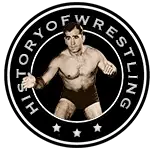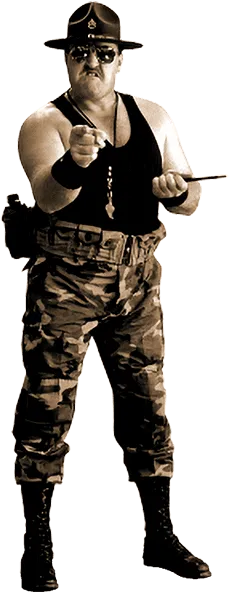by Stephen Von Slagle
Born in Detroit, Michigan, on August 27, 1948, the man who would eventually go on to worldwide fame as Sergeant Slaughter, Bob Remus, grew up in Eden Prairie, Minnesota. Excelling at both wrestling and football during his high school years, Remus began his professional wrestling career in 1972, after completing his training with Minnesota legend Verne Gagne. Originally competing in the Vancouver territory as “Beautiful” Bobby Remus, he adopted a very flamboyant persona, sporting blond hair and wearing tie-dye clothing, ala “Superstar” Billy Graham. However, without the exceptional body nor the superlative promo skills of The Superstar, “Beautiful” Bobby Remus came across as a somewhat weak copy of Graham, which is essentially what the character was. Wisely, he soon decided to alter his gimmick, discarding his colorful wardrobe and, after briefly competing simply as Bob Remus, replaced both personas with something quite different and far more original.
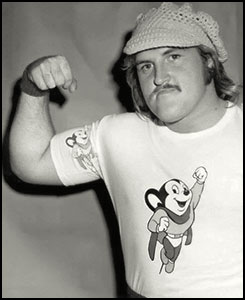 After his short stay in Gene Kiniski’s Vancouver territory, and, later, Don Owens’ Portland league, Bob Remus moved on, making his debut in two different, yet very similar promotions. First, Leroy McGuirk’s Tulsa-based Tri-State Wrestling, where he quickly became a co-holder of the NWA United States Tag Team title with partner Col. Buck Robely early in 1976. At the same time, Slaughter began wrestling in the Central States promotion, under the name D.I. Bob Slaughter. Soon after entering the Kansas City-based group, the Drill Instructor cut back on his Tri-State commitments and joined the Central States promotion full-time. Although he was still basically a rookie in the business, the talented 6’5″ 300 lb. Slaughter quickly acclimated himself, impressing both fans and management with his size & speed as well as a solid grasp of wrestling fundamentals and ring psychology. However, even more than the big man’s ring ability, Remus’ new gimmick enabled him to become a main-event level star in the rugged Central States promotion almost immediately. While it was not necessarily one of the NWA’s more profitable or widely viewed territories, history has proven that Bob Geigel’s no-frills Central States promotion was one of the best places for a young performer to learn his craft before moving on to bigger and better things. Future superstars such as Slaughter, Dusty Rhodes, Jesse Ventura, Ted Dibiase, and Crusher Blackwell (among many others) all began their careers with tours in the Central States promotion where, despite their lack of time in the business, they were able to receive valuable ring experience while wrestling in matches at the top of the card.
After his short stay in Gene Kiniski’s Vancouver territory, and, later, Don Owens’ Portland league, Bob Remus moved on, making his debut in two different, yet very similar promotions. First, Leroy McGuirk’s Tulsa-based Tri-State Wrestling, where he quickly became a co-holder of the NWA United States Tag Team title with partner Col. Buck Robely early in 1976. At the same time, Slaughter began wrestling in the Central States promotion, under the name D.I. Bob Slaughter. Soon after entering the Kansas City-based group, the Drill Instructor cut back on his Tri-State commitments and joined the Central States promotion full-time. Although he was still basically a rookie in the business, the talented 6’5″ 300 lb. Slaughter quickly acclimated himself, impressing both fans and management with his size & speed as well as a solid grasp of wrestling fundamentals and ring psychology. However, even more than the big man’s ring ability, Remus’ new gimmick enabled him to become a main-event level star in the rugged Central States promotion almost immediately. While it was not necessarily one of the NWA’s more profitable or widely viewed territories, history has proven that Bob Geigel’s no-frills Central States promotion was one of the best places for a young performer to learn his craft before moving on to bigger and better things. Future superstars such as Slaughter, Dusty Rhodes, Jesse Ventura, Ted Dibiase, and Crusher Blackwell (among many others) all began their careers with tours in the Central States promotion where, despite their lack of time in the business, they were able to receive valuable ring experience while wrestling in matches at the top of the card.
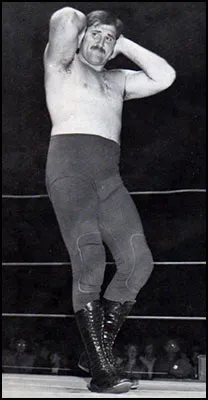 Portraying a former marine Drill Instructor who was dishonorably discharged from the service because of his penchant for brutalizing young recruits, D.I. Bob Slaughter was a truly imposing figure within the Midwestern promotion and a very unique, innovative character at that time in pro wrestling. Although the sport had featured a few military-type wrestlers in the past, they were invariably portrayed as evil foreigners, certainly not an American, let alone one who was a heel. However, there were few villains as ruthless, sadistic or brutal as D.I. Bob Slaughter. Soon after his arrival, the growling, stone-jawed D.I. established himself as the number one heel in the Central States territory and he feuded with a number of the region’s top fan favorites of the day, including Mike George, Ted Oates, “Bulldog” Bob Brown and Rufus R. Jones. After plowing his way to the top of the card, Slaughter’s hard work and professionalism was rewarded with a victory in January of 1977 for the region’s biggest prize, the Central States Heavyweight title. The intimidating, rule-breaking former Marine defended his new championship frequently, using any means necessary to hold on to his coveted title. Yet, as was customary during this period, his reign as a regional titleholder did not last particularly long and on February 4, 1977, Slaughter was defeated by the popular Ted Oates in St. Joseph, Missouri for the Central States Heavyweight championship. However, the title loss was simply a means to advance his storyline with Oates, and a week later the D.I. regained his Central States championship, once again in St. Joseph. From there, the merciless Slaughter began a program with “Bulldog” Bob Brown, who was a fixture of the Midwestern promotion.
Portraying a former marine Drill Instructor who was dishonorably discharged from the service because of his penchant for brutalizing young recruits, D.I. Bob Slaughter was a truly imposing figure within the Midwestern promotion and a very unique, innovative character at that time in pro wrestling. Although the sport had featured a few military-type wrestlers in the past, they were invariably portrayed as evil foreigners, certainly not an American, let alone one who was a heel. However, there were few villains as ruthless, sadistic or brutal as D.I. Bob Slaughter. Soon after his arrival, the growling, stone-jawed D.I. established himself as the number one heel in the Central States territory and he feuded with a number of the region’s top fan favorites of the day, including Mike George, Ted Oates, “Bulldog” Bob Brown and Rufus R. Jones. After plowing his way to the top of the card, Slaughter’s hard work and professionalism was rewarded with a victory in January of 1977 for the region’s biggest prize, the Central States Heavyweight title. The intimidating, rule-breaking former Marine defended his new championship frequently, using any means necessary to hold on to his coveted title. Yet, as was customary during this period, his reign as a regional titleholder did not last particularly long and on February 4, 1977, Slaughter was defeated by the popular Ted Oates in St. Joseph, Missouri for the Central States Heavyweight championship. However, the title loss was simply a means to advance his storyline with Oates, and a week later the D.I. regained his Central States championship, once again in St. Joseph. From there, the merciless Slaughter began a program with “Bulldog” Bob Brown, who was a fixture of the Midwestern promotion.
After months of heated nightly battles in Central States cities such as Des Moines, Kansas City, Wichita and St. Joseph, Brown was eventually able to defeat Slaughter for the title. However, as was the case when he dropped the championship to Ted Oates, Slaughter soon regained his Central States title (for the third time) by defeating Brown in a rematch just a few weeks later. It was also during this time period that Remus developed the idea of having a top babyface encourage the fans to call him “Gomer” (in reference to the bumbling, moronic Marine portrayed by Jim Neighbors on TV’s Gomer Pyle, U.S.M.C.). Once the fans began their chant of “Gom-er! Gom-er!” Slaughter would then become red-faced with anger, covering his ears and refusing to continue with the match until the antagonistic audience settled down, which, of course, was never the case. The interactive, fan-friendly “Gomer gimmick” worked extremely well for Slaughter, who went on to use it (with great success) at one point or another in virtually every promotion he worked for from that point forward. After several more months as the Central States champion, D.I. Bob Slaughter’s reign on top of the territory finally came to an end when he lost the title to another fast-rising star, the popular young Ted Dibiase, on May 19, 1977 in Kansas City, Kansas. Although he was granted several rematches against the rookie second-generation star, Slaughter was unable to regain his Central States championship from the talented young Dibiase and a few months after dropping the title, the massive D.I. Bob Slaughter dropped out of not only the Central States promotion, but the wrestling scene altogether.
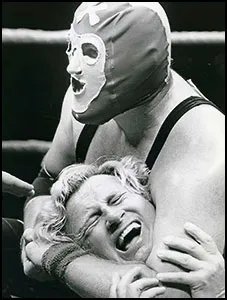 At the same time in the American Wrestling Association, a gigantic new six-five, three hundred pound masked man by the name of Super Destroyer Mark II suddenly appeared in the promotion under the tutelage of the despised Englishman, Lord Alfred Hayes. The dangerous new masked man carried on in the tradition of the original Super Destroyer (Don Jardine a.k.a. The Spoiler) who was previously managed by Hayes in the AWA, and immediately upon his arrival, Super Destroyer Mark II became deeply involved in the snobbish manager’s ongoing feud with The Crusher. Lord Hayes’ mysterious and powerful new protégé, who was billed as hailing from Gibraltar, posed a very serious threat to “The Wrestler Who Made Milwaukee Famous” as well as several other top AWA competitors, including the popular Greg Gagne and the English shooter Billy Robinson. In fact, it was against Robinson that Super Destroyer Mark II won his sole AWA championship, the AWA British Empire title, on September 25, 1979 in Winnipeg, Manitoba. During his time in the promotion, the silent, hulking Super Destroyer, led by the elitist Lord Hayes, was a rulebreaking force like few others in the American Wrestling Association. But, after betraying his manager Alfred Hayes (who then became a popular babyface) and joining Bobby Heenan’s stable, the monolithic Super Destroyer was eventually unmasked and soon faded from the AWA territory.
At the same time in the American Wrestling Association, a gigantic new six-five, three hundred pound masked man by the name of Super Destroyer Mark II suddenly appeared in the promotion under the tutelage of the despised Englishman, Lord Alfred Hayes. The dangerous new masked man carried on in the tradition of the original Super Destroyer (Don Jardine a.k.a. The Spoiler) who was previously managed by Hayes in the AWA, and immediately upon his arrival, Super Destroyer Mark II became deeply involved in the snobbish manager’s ongoing feud with The Crusher. Lord Hayes’ mysterious and powerful new protégé, who was billed as hailing from Gibraltar, posed a very serious threat to “The Wrestler Who Made Milwaukee Famous” as well as several other top AWA competitors, including the popular Greg Gagne and the English shooter Billy Robinson. In fact, it was against Robinson that Super Destroyer Mark II won his sole AWA championship, the AWA British Empire title, on September 25, 1979 in Winnipeg, Manitoba. During his time in the promotion, the silent, hulking Super Destroyer, led by the elitist Lord Hayes, was a rulebreaking force like few others in the American Wrestling Association. But, after betraying his manager Alfred Hayes (who then became a popular babyface) and joining Bobby Heenan’s stable, the monolithic Super Destroyer was eventually unmasked and soon faded from the AWA territory.
Not long after the departure of Super Destroyer Mark II, a relative unknown by the name of Sgt. Slaughter suddenly appeared in the WWF, under the tutelage of the devious Grand Wizard of Wrestling. The impressive but “unproven” military man quickly rose not only to the occasion, but also to the top of the promotion’s rankings. No longer a Drill Instructor, the newly renamed Sergeant Slaughter posed a genuinely serious threat to Bob Backlund’s WWF Heavyweight title and their wild matches throughout the territory, including New York’s Madison Square Garden, always took place before capacity crowds. After making a huge impression on northeastern fans during his exciting (albeit relatively brief) first run in the WWF, the ruthless Sgt. Slaughter entered yet another red-hot territory, Jim Crockett’s Mid-Atlantic Wrestling promotion. Soon after entering the territory, Slaughter (with an impressive offensive arsenal that included his feared Cobra Clutch sleeper-hold and the devastating Slaughter Cannon, which was a flying clothesline from the second turnbuckle) defeated the most popular “puke” in the region at that time, Rick Steamboat, in the finals of a tournament to decide the new NWA United States Heavyweight champion.
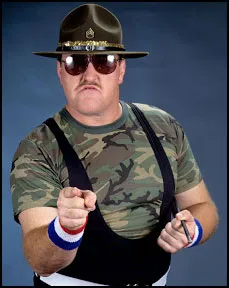 As the reigning United States Heavyweight champion, Sgt. Slaughter took on the best that the Mid-Atlantic had to offer, including challenges from top names like Steamboat, Jack Brisco and Roddy Piper. However, it was against the rugged former NFL star Wahoo McDaniel that Slaughter finally lost his prized championship, after holding the prestigious title for over a half-year. With the previously mentioned “Gomer Gimmick” once again in full effect, Slaughter and Wahoo entered into a very intense, bloody and profitable feud with one another and the “hatred” between the two only intensified with McDaniel’s victory over the detested Sergeant. Slaughter would gain his revenge, though, when the NWA stripped McDaniel of the U.S. title following an “injury” that took the popular Native American out of action for several weeks. To Slaughter’s delight, and the fans’ dismay, the NWA awarded the title to the previous champion, Sgt. Slaughter, on June 7, 1982. Yet, there was more to be written in the story of Slaughter vs. McDaniel, and on August 22, 1982, a recuperated Wahoo pinned his hated rival in Charlotte, North Carolina. to regain the coveted United States championship. Within weeks, though, Sgt. Slaughter was back in the title picture, this time with Pvt. Don Kernodle, with whom he won the NWA World Tag Team championship in September of 1982. With the overbearing Sergeant constantly barking orders at his eager young recruit, the entertaining heel duo went on to rule Mid Atlantic’s tag team division for more than seven months. During this time, the villainous duo began a heated feud with the most popular babyface team in the area, Rick Steamboat & Jay Youngblood. The two teams waged war against each other in a red-hot program for months before Slaughter and Kernodle were finally dethroned by Steamboat and Youngblood, inside of a steel cage, on March 12, 1983. Meanwhile, the NWA’s Toronto office, which was operated by Jack Tunney, had a very close working relationship with the Mid-Atlantic territory in the years prior to Tunney’s group joining the WWF in the Summer of 1984. As a result, Toronto was a regular stop for the Mid-Atlantic’s top stars, Slaughter included, and on July 24, 1983, Sgt. Slaughter continued his winning ways by defeating the massive Angelo “King Kong” Mosca for the NWA Canadian Heavyweight championship in Toronto. The pair of three hundred pounders went on to feud with each other for the remainder of 1983 before Mosca was finally able to dethrone Slaughter and regain the Canadian championship. The title switch marked a period of change for Sgt. Slaughter, who, soon after dropping the title to Mosca, left the NWA to return to the World Wrestling Federation.
As the reigning United States Heavyweight champion, Sgt. Slaughter took on the best that the Mid-Atlantic had to offer, including challenges from top names like Steamboat, Jack Brisco and Roddy Piper. However, it was against the rugged former NFL star Wahoo McDaniel that Slaughter finally lost his prized championship, after holding the prestigious title for over a half-year. With the previously mentioned “Gomer Gimmick” once again in full effect, Slaughter and Wahoo entered into a very intense, bloody and profitable feud with one another and the “hatred” between the two only intensified with McDaniel’s victory over the detested Sergeant. Slaughter would gain his revenge, though, when the NWA stripped McDaniel of the U.S. title following an “injury” that took the popular Native American out of action for several weeks. To Slaughter’s delight, and the fans’ dismay, the NWA awarded the title to the previous champion, Sgt. Slaughter, on June 7, 1982. Yet, there was more to be written in the story of Slaughter vs. McDaniel, and on August 22, 1982, a recuperated Wahoo pinned his hated rival in Charlotte, North Carolina. to regain the coveted United States championship. Within weeks, though, Sgt. Slaughter was back in the title picture, this time with Pvt. Don Kernodle, with whom he won the NWA World Tag Team championship in September of 1982. With the overbearing Sergeant constantly barking orders at his eager young recruit, the entertaining heel duo went on to rule Mid Atlantic’s tag team division for more than seven months. During this time, the villainous duo began a heated feud with the most popular babyface team in the area, Rick Steamboat & Jay Youngblood. The two teams waged war against each other in a red-hot program for months before Slaughter and Kernodle were finally dethroned by Steamboat and Youngblood, inside of a steel cage, on March 12, 1983. Meanwhile, the NWA’s Toronto office, which was operated by Jack Tunney, had a very close working relationship with the Mid-Atlantic territory in the years prior to Tunney’s group joining the WWF in the Summer of 1984. As a result, Toronto was a regular stop for the Mid-Atlantic’s top stars, Slaughter included, and on July 24, 1983, Sgt. Slaughter continued his winning ways by defeating the massive Angelo “King Kong” Mosca for the NWA Canadian Heavyweight championship in Toronto. The pair of three hundred pounders went on to feud with each other for the remainder of 1983 before Mosca was finally able to dethrone Slaughter and regain the Canadian championship. The title switch marked a period of change for Sgt. Slaughter, who, soon after dropping the title to Mosca, left the NWA to return to the World Wrestling Federation.
Back in the WWF, Slaughter picked up right where he’d left off a couple of years earlier, under the watchful eye of his manager, The Grand Wizard of Wrestling. Slaughter took on the top fan favorites of the day while further alienating himself from the Federation’s substantial audience by referring to them as “maggots” and “pukes.” Meanwhile, he resumed his feud with WWF champion Bob Backlund, selling out Madison Square twice more for his matches against “The All American Boy.” Soon after his re-entry into the Federation, Slaughter & The Wizard also began offering $5,000 to any wrestler who could break free of the dreaded Cobra Clutch sleeper hold within a ninety-second time period. Despite the fact that many wrestlers (including several popular young up-and-comers, such as “Quick Draw” Rick McGraw and Rick Martel, among others) lined up in order to collect an “easy” five grand from Slaughter, week after week, the incredibly aggressive, borderline-psychotic former Marine’s feared maneuver proved to be virtually inescapable once The Sarge had it locked on properly. Furthermore, rather than simply prove that his hold was as unbreakable as he claimed, Slaughter would often continue on past the allotted ninety-second mark, intentionally rendering his victims unconscious with the Cobra Clutch and then sadistically battering them with impunity.
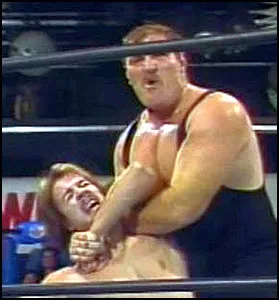 The lengthy, ongoing angle came to a head when, following one of Slaughter’s “Cobra Clutch Challenge” segments on WWF All Star Wrestling, an arrogant and confrontational Slaughter (egged on by the scheming Grand Wizard) insulted commentator Pat Patterson, who was interviewing the hated duo at ringside, amidst a deafening chant of “Go-mer!” Calling him “a yellow maggot coward,” Slaughter then sucker-punched the retired Patterson with a stiff right hand to the jaw. As the fans in attendance continued to verbally provoke Slaughter, Patterson, who was more enraged than physically hurt, tore his suitcoat off and climbed into the ring, demanding that Slaughter apply his “unbreakable” hold. After consulting The Wizard, a cautious Sgt. Slaughter climbed through the ropes, stood behind Patterson (who was seated in a chair that had been placed in the middle of the ring) and then quickly slapped on the Cobra Clutch. Patterson was prepared, though, and in short order the gifted veteran came very close to breaking the hold several times. Finally, after stunning the big man by slamming him backwards into the corner of the ring, he was able to loosen Slaughter’s grip and it appeared that Patterson was just seconds away from totally breaking free from The Cobra Clutch. Realizing that he was about to lose not only his $5,000 but also his pride, Slaughter released the hold and viciously attacked Patterson, bloodying him with a folding chair and then clamping the Cobra back on his helpless victim. With blood flowing freely down the side of Patterson’s face, Slaughter squeezed with all of his might as he rendered the retired legend unconscious. Eventually, several wrestlers came to Patterson’s aid, however, the damage had been done…and the Slaughter-Patterson war was definitely on.
The lengthy, ongoing angle came to a head when, following one of Slaughter’s “Cobra Clutch Challenge” segments on WWF All Star Wrestling, an arrogant and confrontational Slaughter (egged on by the scheming Grand Wizard) insulted commentator Pat Patterson, who was interviewing the hated duo at ringside, amidst a deafening chant of “Go-mer!” Calling him “a yellow maggot coward,” Slaughter then sucker-punched the retired Patterson with a stiff right hand to the jaw. As the fans in attendance continued to verbally provoke Slaughter, Patterson, who was more enraged than physically hurt, tore his suitcoat off and climbed into the ring, demanding that Slaughter apply his “unbreakable” hold. After consulting The Wizard, a cautious Sgt. Slaughter climbed through the ropes, stood behind Patterson (who was seated in a chair that had been placed in the middle of the ring) and then quickly slapped on the Cobra Clutch. Patterson was prepared, though, and in short order the gifted veteran came very close to breaking the hold several times. Finally, after stunning the big man by slamming him backwards into the corner of the ring, he was able to loosen Slaughter’s grip and it appeared that Patterson was just seconds away from totally breaking free from The Cobra Clutch. Realizing that he was about to lose not only his $5,000 but also his pride, Slaughter released the hold and viciously attacked Patterson, bloodying him with a folding chair and then clamping the Cobra back on his helpless victim. With blood flowing freely down the side of Patterson’s face, Slaughter squeezed with all of his might as he rendered the retired legend unconscious. Eventually, several wrestlers came to Patterson’s aid, however, the damage had been done…and the Slaughter-Patterson war was definitely on.
Over the course of the next several weeks, Slaughter and Patterson battled in major arenas throughout the WWF, and their feud (which carried more fan interest than any other program in the territory at the time, including that of the Heavyweight champion Bob Backlund) intensified with each bloody encounter. Finally, their mutual animosity grew to the point where something had to be done in order to put an end to the ever-escalating level of violence and hatred. That “something” came in the form of a come-as-you-are, no DQ, no time limit, no count-out, feud-ending “Boot Camp Match.” It was during this time period that Vince McMahon, Jr. began to take his World Wrestling Federation national, and the first choice on his list to lead the promotion as the new, post-Backlund WWF champion was none other than Sgt. Slaughter. Seeing the potential in a babyface version of The Sarge, McMahon set about transforming Slaughter from the most despised man in the Federation to the most popular.
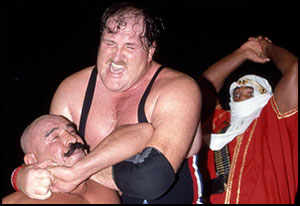 The catalyst of the hated patriot’s unlikely metamorphosis came in the form of the Iranian heel known worldwide as the Iron Sheik, who was nearly as unpopular with the fans as Sgt. Slaughter had been. The angle was kicked off when the Sheik, who had remained in the ring after a match, arguing with anti-Iranian fans, finally headed back to the dressing room area. As he walked down the aisle to return backstage, Sgt. Slaughter was simultaneously coming down to the ring for his upcoming bout. With a sense of tension thick in the air, the two natural enemies slowed and then stopped as they came to each other, engaging in a lengthy stare down while the audience in attendance instantaneously rallied behind the heretofore despised Sgt. Slaughter. Before the situation could escalate any further, several referees (as well as The Sheik’s manager, Fred Blassie) stepped between the two, and The Sheik continued to the back while Slaughter entered the ring for his match. The next week, however, Slaughter and The Sheik had another confrontation which quickly became very violent, with the unscrupulous Sheik temporarily getting the best of Slaughter. At the same time, the unlikely popularity of Sgt. Slaughter grew to unforeseen (even by McMahon) levels almost overnight, and the rugged superpatriot soon became, by far, the most popular wrestler in the WWF and, by extension, the entire country. In the meantime, however, the opportunity arose for McMahon to sign Hulk Hogan away from the AWA, and the rest, as they say, is history.
The catalyst of the hated patriot’s unlikely metamorphosis came in the form of the Iranian heel known worldwide as the Iron Sheik, who was nearly as unpopular with the fans as Sgt. Slaughter had been. The angle was kicked off when the Sheik, who had remained in the ring after a match, arguing with anti-Iranian fans, finally headed back to the dressing room area. As he walked down the aisle to return backstage, Sgt. Slaughter was simultaneously coming down to the ring for his upcoming bout. With a sense of tension thick in the air, the two natural enemies slowed and then stopped as they came to each other, engaging in a lengthy stare down while the audience in attendance instantaneously rallied behind the heretofore despised Sgt. Slaughter. Before the situation could escalate any further, several referees (as well as The Sheik’s manager, Fred Blassie) stepped between the two, and The Sheik continued to the back while Slaughter entered the ring for his match. The next week, however, Slaughter and The Sheik had another confrontation which quickly became very violent, with the unscrupulous Sheik temporarily getting the best of Slaughter. At the same time, the unlikely popularity of Sgt. Slaughter grew to unforeseen (even by McMahon) levels almost overnight, and the rugged superpatriot soon became, by far, the most popular wrestler in the WWF and, by extension, the entire country. In the meantime, however, the opportunity arose for McMahon to sign Hulk Hogan away from the AWA, and the rest, as they say, is history.
Following the arrival of Hogan and the rise of Hulk-a-Mania, Sgt. Slaughter remained in the promotion, at least temporarily, and continued to enjoy a level of popularity that surpassed even that of the newly arrived Hulkster. Yet, feeling that McMahon had not come through on several championship promises he’d made, as well as butting heads on Slaughter’s G.I. Joe contract, Slaughter left the Federation late in 1984. Despite severing his ties with McMahon and the WWF, Bob Remus’ lucrative (and, at the time, unprecedented) deal with Marvel Comics remained intact and Sgt. Slaughter’s high-profile position as a member of the hugely popular G.I. Joe series continued, allowing his well-known likeness to remain quite visible to the large adolescent audience that Slaughter’s former employer sought so fervently. Meanwhile, to the delight of AWA owner/operator Verne Gagne (who had lost nearly all of his top wrestlers to the WWF’s relentless talent raids) the world-famous Sgt. Slaughter chose to return to the American Wrestling Association early in 1985, giving the beleaguered promotion a much needed (and very public) big-name talent acquisition.
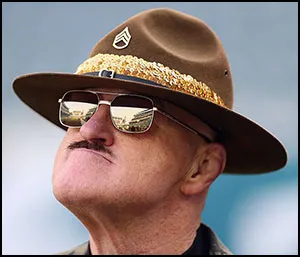 Upon entering the promotion, Slaughter was billed as the first (and only) AWA Americas titleholder, which was a championship prop created exclusively for Sgt. Slaughter while the AWA’s other top babyface, Rick Martel, continued to hold the World championship. Not surprisingly, the famous patriot immediately engaged in several high-profile feuds with some of the biggest, baddest, anti-American heels in the company… The Sarge was drawn into a natural rivalry with the massive Communist bulldozer Boris Zhukov, as well as his hated Iraqi manager, Sheik Adnan Al-Kassie. Additionally, Slaughter became involved in a bitter feud with the controversial South African bigot, Col. DeBeers. Later, once “The Living Legend” Larry Zbyszko had captured the AWA World Heavyweight title, he was forced to grant frequent title shots to his number one contender, the hugely popular Americas champion, Sgt. Slaughter. The controversial new AWA World champion’s hands were more than full with the challenge of the mighty Sgt. Slaughter and after several face-offs (each time barely escaping with his title reign intact) Zbyszko finally lost his World championship to the ultra-popular national hero. As the the live audience exploded in cheers for the beloved new champion, Slaughter returned to the locker room with the AWA World championship belt firmly locked around his waist. However, as was often the case with the AWA, Sgt. Slaughter’s well-received title victory was reversed the very next week due to a “technicality,” an overused booking practice that greatly contributed to the promotion’s previously unthinkable downfall just a few years later. Despite Slaughter’s protests, the A,W,A, World championship belt was returned to “The Living Legend.” Although he made several more subsequent trips to “Larryland,” the massive patriot was never again able to defeat Zbyszko for the AWA World title. For the better part of five years, Sgt. Slaughter was a major player within the American Wrestling Association, and in addition to being one of the few draws on the AWA’s ESPN wrestling program, the popular big man took part in several of the various AWA supercards and closed-circuit events, including, among others, WrestleRock `86 and the three SuperClash cards. However, late in 1989, Slaughter left the beleaguered AWA and moved on to other challenges, including a brief run with the short-lived A.W.F. promotion, as well as a few other smaller independent groups. Then, in 1990, Bob Remus finally received the phone call that he felt had been coming his way for more than half a decade…
Upon entering the promotion, Slaughter was billed as the first (and only) AWA Americas titleholder, which was a championship prop created exclusively for Sgt. Slaughter while the AWA’s other top babyface, Rick Martel, continued to hold the World championship. Not surprisingly, the famous patriot immediately engaged in several high-profile feuds with some of the biggest, baddest, anti-American heels in the company… The Sarge was drawn into a natural rivalry with the massive Communist bulldozer Boris Zhukov, as well as his hated Iraqi manager, Sheik Adnan Al-Kassie. Additionally, Slaughter became involved in a bitter feud with the controversial South African bigot, Col. DeBeers. Later, once “The Living Legend” Larry Zbyszko had captured the AWA World Heavyweight title, he was forced to grant frequent title shots to his number one contender, the hugely popular Americas champion, Sgt. Slaughter. The controversial new AWA World champion’s hands were more than full with the challenge of the mighty Sgt. Slaughter and after several face-offs (each time barely escaping with his title reign intact) Zbyszko finally lost his World championship to the ultra-popular national hero. As the the live audience exploded in cheers for the beloved new champion, Slaughter returned to the locker room with the AWA World championship belt firmly locked around his waist. However, as was often the case with the AWA, Sgt. Slaughter’s well-received title victory was reversed the very next week due to a “technicality,” an overused booking practice that greatly contributed to the promotion’s previously unthinkable downfall just a few years later. Despite Slaughter’s protests, the A,W,A, World championship belt was returned to “The Living Legend.” Although he made several more subsequent trips to “Larryland,” the massive patriot was never again able to defeat Zbyszko for the AWA World title. For the better part of five years, Sgt. Slaughter was a major player within the American Wrestling Association, and in addition to being one of the few draws on the AWA’s ESPN wrestling program, the popular big man took part in several of the various AWA supercards and closed-circuit events, including, among others, WrestleRock `86 and the three SuperClash cards. However, late in 1989, Slaughter left the beleaguered AWA and moved on to other challenges, including a brief run with the short-lived A.W.F. promotion, as well as a few other smaller independent groups. Then, in 1990, Bob Remus finally received the phone call that he felt had been coming his way for more than half a decade…
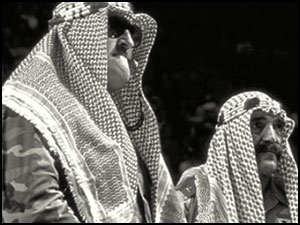 Late in 1990, vignettes began running on WWF television programs that depicted Sgt. Slaughter in various combat scenarios. Clearly, this Sgt. Slaughter was not the same American hero that had been the most popular superstar in the WWF just five years earlier. Indeed, to the dismay of his legion of former fans, the deranged, sadistic, ultra right-wing Sgt. Slaughter of old was back and it became immediately apparent that no one in the WWF was safe from his misguided wrath. After making his re-debut, Slaughter bulldozed through every opponent placed before him, cheating at every opportunity and blaming the fans for “turning” on him. Eventually, he established himself the number one contender for the WWF title, which was held at the time by The Ultimate Warrior. At the 1991 installment of the Royal Rumble, Slaughter and The Warrior went one-on-one in Miami for the World Wrestling Federation championship. Unfortunate for the Ultimate Warrior, however, was the fact that the match turned out to be a two-on-one encounter when his chief rival at that time, “Macho Man” Randy Savage, ran down to ringside and interfered on Slaughter’s behalf, allowing the warped Sergeant to pin his stunned foe and become the WWF champion. Vince McMahon had finally made good on his promise.
Late in 1990, vignettes began running on WWF television programs that depicted Sgt. Slaughter in various combat scenarios. Clearly, this Sgt. Slaughter was not the same American hero that had been the most popular superstar in the WWF just five years earlier. Indeed, to the dismay of his legion of former fans, the deranged, sadistic, ultra right-wing Sgt. Slaughter of old was back and it became immediately apparent that no one in the WWF was safe from his misguided wrath. After making his re-debut, Slaughter bulldozed through every opponent placed before him, cheating at every opportunity and blaming the fans for “turning” on him. Eventually, he established himself the number one contender for the WWF title, which was held at the time by The Ultimate Warrior. At the 1991 installment of the Royal Rumble, Slaughter and The Warrior went one-on-one in Miami for the World Wrestling Federation championship. Unfortunate for the Ultimate Warrior, however, was the fact that the match turned out to be a two-on-one encounter when his chief rival at that time, “Macho Man” Randy Savage, ran down to ringside and interfered on Slaughter’s behalf, allowing the warped Sergeant to pin his stunned foe and become the WWF champion. Vince McMahon had finally made good on his promise.
The “new” Sgt. Slaughter seemed to revel in his previous heel persona, the first time he had performed in that capacity since the early-Eighties. Completely uncoincidental was the fact that Slaughter’s return and rise to the top of the WWF took place simultaneously with the escalation of the United States’ conflict with Iraq over its invasion of neighboring Kuwait. Some disagreed with the WWF for going through with a storyline that was based on actual ongoing events (featuring a traitorous anti-American as the lead character, no less) especially during a very real war in which people were dying. However, while it may not have been particularly tasteful, the abundant patriotism resultant of a war-time mentality did add a great deal of intensity to Slaughter’s reign, particularly when the turncoat patriot debuted his new Iraqi manager (and former AWA rival) Adnan Al-Kassie. The influence of Al-Kassie (who had gone from a “Sheik” to a “General”) soon became apparent when the former U.S. Marine began wearing an Iraqi military uniform to the ring. Later, Slaughter and General Adnan were joined by, of all people, the hated Iranian and former Slaughter archrival, The Iron Sheik. Granted, it was “cheap heat,” but it was also the kind of heat that was extremely effective at eliciting a visceral emotional response from the wrestling fanbase. Going into his WrestleMania VII title defense against Hulk Hogan, the negative reaction that the traitorous WWF champion consistently incited from his audience was truly substantial, if not a bit frightening.
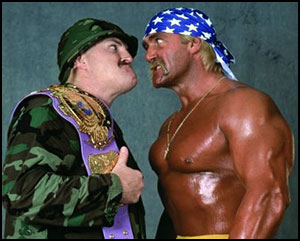 Leading up to the big event, the venue for WrestleMania VII was moved from the cavernous, 100,000 seat L.A. Coliseum to the “safer” L.A. Sports Arena. While the mainstream media seemed to accept the WWF’s explanation that the sudden venue change was due to security concerns prompted by threats of “terrorism” and not due to poor ticket sales, informed observers of the sport were less than convinced. Nevertheless, some 20,000 spectators turned out to see the most patriotic wrestler in the Federation, “The Immortal” Hulk Hogan face the despised Sgt. Slaughter for the WWF title. Although he was dominated by Slaughter for the majority of their WrestleMania showdown, a bloody and battered Hogan, the WWF’s “Real American,” battled seemingly insurmountable odds to defeat General Adnan’s champion on March 24, 1991, taking the traitorous Slaughter’s belt and returning honor to the WWF championship.
Leading up to the big event, the venue for WrestleMania VII was moved from the cavernous, 100,000 seat L.A. Coliseum to the “safer” L.A. Sports Arena. While the mainstream media seemed to accept the WWF’s explanation that the sudden venue change was due to security concerns prompted by threats of “terrorism” and not due to poor ticket sales, informed observers of the sport were less than convinced. Nevertheless, some 20,000 spectators turned out to see the most patriotic wrestler in the Federation, “The Immortal” Hulk Hogan face the despised Sgt. Slaughter for the WWF title. Although he was dominated by Slaughter for the majority of their WrestleMania showdown, a bloody and battered Hogan, the WWF’s “Real American,” battled seemingly insurmountable odds to defeat General Adnan’s champion on March 24, 1991, taking the traitorous Slaughter’s belt and returning honor to the WWF championship.
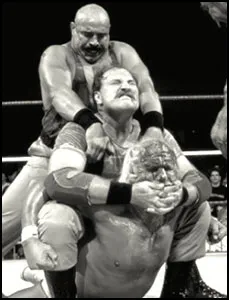 Following his loss of the WWF title to Hogan, Slaughter remained a very visible part of the Federation, and after his feud with The Hulkster concluded, he entered into another major program with the overtly patriotic (and hugely popular) “Hacksaw” Jim Duggan. However, following the controversy that resulted from the Hogan-Slaughter storyline, the WWF scaled back on some of the more provocative aspects of his character and, eventually, went so far as to turn Sgt. Slaughter into a babyface…an arduous task, indeed. Even after being betrayed and attacked by General Adnan and The Iron Sheik, the unforgiving fans were slow to embrace Slaughter. Understanding of their hesitance in accepting his apologies, a remorseful Sarge vowed to win back the fans’ trust, no matter how long it took. In the end, though, it didn’t take long at all for the icy fan reaction to Slaughter’s babyface turn to thaw, and he once again received the support of the WWF fanbase, although his popularity never again reached the incredible level achieved during his initial run as a fan favorite years earlier. After another solid run as a WWF hero, Sgt. Slaughter quietly faded from the scenes. He did not, however, fade from the WWF and after his retirement, Bob Remus stayed on with the company as a member of Titan Sports’ management team, specifically as a road agent. Then, in the late-Nineties, Sgt. Slaughter re-emerged on Federation television as the new trouble shooting, no-nonsense WWF Commissioner. As the Commish, Slaughter played an important role in the storylines of several top WWF superstars, including members of De-Generation X, “Stone Cold” Steve Austin and others before once again leaving the public eye and returning to his important duties backstage.
Following his loss of the WWF title to Hogan, Slaughter remained a very visible part of the Federation, and after his feud with The Hulkster concluded, he entered into another major program with the overtly patriotic (and hugely popular) “Hacksaw” Jim Duggan. However, following the controversy that resulted from the Hogan-Slaughter storyline, the WWF scaled back on some of the more provocative aspects of his character and, eventually, went so far as to turn Sgt. Slaughter into a babyface…an arduous task, indeed. Even after being betrayed and attacked by General Adnan and The Iron Sheik, the unforgiving fans were slow to embrace Slaughter. Understanding of their hesitance in accepting his apologies, a remorseful Sarge vowed to win back the fans’ trust, no matter how long it took. In the end, though, it didn’t take long at all for the icy fan reaction to Slaughter’s babyface turn to thaw, and he once again received the support of the WWF fanbase, although his popularity never again reached the incredible level achieved during his initial run as a fan favorite years earlier. After another solid run as a WWF hero, Sgt. Slaughter quietly faded from the scenes. He did not, however, fade from the WWF and after his retirement, Bob Remus stayed on with the company as a member of Titan Sports’ management team, specifically as a road agent. Then, in the late-Nineties, Sgt. Slaughter re-emerged on Federation television as the new trouble shooting, no-nonsense WWF Commissioner. As the Commish, Slaughter played an important role in the storylines of several top WWF superstars, including members of De-Generation X, “Stone Cold” Steve Austin and others before once again leaving the public eye and returning to his important duties backstage.
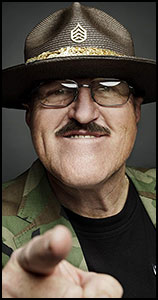 As the new millennium was ushered in, Sgt. Slaughter remained a fixture of WWE, making occasional on-camera appearances in addition to his behind-the-scenes management duties. Then, early in 2020, controversy regarding Bob Remus’ actual military history prior to becoming a wrestler emerged. For some reason, people actually believed the he had, indeed, been a Marine earlier in life, perhaps because Remus always remained in character while doing media interviews and making public appearances. When it was “revealed” that neither Bob Remus, nor his fictional alter-ego Sgt. Slaughter, had, in fact, been a member of the armed services, accusations of “Stolen Valor” were leveled by offended parties. Clearly, rather than it being a case of maintaining a malevolent lie, Remus was simply staying true to the persona of Sgt. Slaughter when ambiguously sighting past military involvement and, eventually, the controversy blew over.
As the new millennium was ushered in, Sgt. Slaughter remained a fixture of WWE, making occasional on-camera appearances in addition to his behind-the-scenes management duties. Then, early in 2020, controversy regarding Bob Remus’ actual military history prior to becoming a wrestler emerged. For some reason, people actually believed the he had, indeed, been a Marine earlier in life, perhaps because Remus always remained in character while doing media interviews and making public appearances. When it was “revealed” that neither Bob Remus, nor his fictional alter-ego Sgt. Slaughter, had, in fact, been a member of the armed services, accusations of “Stolen Valor” were leveled by offended parties. Clearly, rather than it being a case of maintaining a malevolent lie, Remus was simply staying true to the persona of Sgt. Slaughter when ambiguously sighting past military involvement and, eventually, the controversy blew over.
Among other awards, Sgt. Slaughter received the Wrestling Observer Newsletter’s Match of the Year award in 1981 for his infamous Boot Camp match against Pat Patterson, as well as Pro Wrestling Illustrated’s Most Hated Wrestler of the Year award in 1991. Additionally, he is a member of the WWE Hall of Fame (2004), the Professional Wrestling Hall of Fame (2016) and the International Wrestling Institute & Museum’s George Tragos/Lou Thesz Professional Wrestling Hall of Fame (2019).
